Research on Dynamic Performance of CRTSⅢ Type Slab Ballastless Track under Long-Term Service
Abstract
:1. Introduction
2. Establishment and Verification of Finite Element Model of CRTIII SBT Structure
2.1. Establishment of a Finite Element Model
2.2. Selection of Finite Element Model Parameters
2.3. Reliability Verification of Finite Element Model
2.3.1. Verification by Static Load Test
- Finite element analysis uses a more idealized model to approximate the actual situation. Although the nonlinearity of material properties, geometric nonlinearity, and state nonlinearity are considered in the model calculation, in order to save calculation costs, some noncritical research components are simplified. For example, a wheelset is modeled with discrete rigid bodies. The finite element software is actually an approximate calculation when analyzing nonlinear behavior, so the finite element results will not exactly match the actual situation.
- When the model is loaded, the loading surface and the bearing surface cannot be absolutely parallel, which aggravates the uneven distribution of stress and displacement of the track structure. Although equipment such as an infrared gradienter is used for leveling during the test, it is impossible to completely eliminate the error caused by the nonparallel condition. In addition, the test environment, data collection, processing of test data, etc., will also affect the authenticity and accuracy of test results.
2.3.2. Reliability Verification of Finite Element Model
3. Study on Dynamic Performance of Track Structure under Fatigue State
3.1. Analysis of Vibration Transmission Law of Track Structure under Axle Falling Impact
3.2. Dynamic Response of Track Structure under Fatigue Load
- With the increase in fatigue load time, the wheel–rail force increases, the rail displacement decreases, the acceleration of rail and base increases obviously, but the acceleration of track slab changes little. The reason is that the fatigue load leads to the decline in the vibration damping performance of the isolation layer, and the action time between the axle and the rail decreases, so the acceleration of the base and the acceleration track slab gradually converge.
- With the increase in fatigue load times, the surface tensile stress of SCC decreases, while the surface compressive stress of base increases, and the two tend to be stable after 20 million loading times. The longitudinal stress on the surface of the track slab is basically unchanged.
- With the increase in the number of fatigue loads, the vertical stress of each layer of the track structure increases, and the vertical stress of the base increases most significantly, increasing by more than 10%.
4. Study on Dynamic Performance of Track Structure under Interface Parting Condition
4.1. Study on Dynamic Performance of Track Structure in the Condition of TEP
4.2. Study on Dynamic Performance of Track Structure in the Condition of RP
4.3. Study on Dynamic Performance of Track Structure in the Condition of TMP
4.4. Study on Dynamic Performance of Track Structure in the Condition of CP
5. Conclusions
- As the CRTSIII SBT structure is a unit slab structure, the impact position tends to move upward after the impact of axle falling. Therefore, along the longitudinal direction of the line, the middle part of the track slab is tensioned and the end is compressed; as the substructure bonded to the track slab, the SCC layer is compressed in the slab and tensioned at the slab end; as a longitudinal structure, the base is tensioned in the surface layer of the base and compressed at the slab end. After the impact, the vertical stress diffuses rapidly into the subgrade structure; only the rail bearing platform near the action point of the surface layer of the track slab is tensioned, and the SCC boss is in contact with the edge of the base groove, resulting in tensile and compressive stresses, respectively.
- Under the fatigue load, the acceleration of rail and base increases obviously, and with the weakening of vibration damping performance of the isolation layer, the acceleration of base and the acceleration of the track slab gradually converge. The longitudinal tensile stress of the SCC surface decreases and that of the base surface increases, while the vertical stress of each layer of track structure increases. The vertical stress of the base increases the most, reaching 44.9%, which is unfavorable to the base structure.
- The dynamic response of each structural layer of the track increases when the interface is partially separated. The acceleration and stress changes of each layer are the most obvious under the point of falling of the axle. Because of falling of the axle, the longitudinal tensile stress of the SCC layer even decreases, and the uneven development of tensile stress easily leads to further development of the parting.
- In the condition of CP, the track slab and the SCC layer are changed from a closely bonded composite structure to being only connected by U-shaped ribs. The acceleration and longitudinal and vertical stresses of the SCC layer are greatly reduced, and the speed and displacement are increased; the acceleration and displacement of the track slab are greatly increased, and the dynamic response of the track structure is significantly increased.
Author Contributions
Funding
Institutional Review Board Statement
Informed Consent Statement
Data Availability Statement
Conflicts of Interest
References
- He, J.; Chen, L.; Zhang, M.-Z.; Ki-hyung, B. Research on the Impact of China’s High-Speed Railway Construction on Regional Economy-Take Xibao High-Speed Rail as an Example. Korea Logist. Rev. 2019, 29, 75–89. [Google Scholar] [CrossRef]
- Shuang, W.; Lee, J. Analysis of Core Competencies for Overseas Expansion of China’s High-speed Railway Industry. J. Korean Soc. Railw. 2020, 23, 374–383. [Google Scholar] [CrossRef]
- Yong-Sang, L.; Byung-Hyun, C. Comparison of High-Speed Railway in East Asia Focusing on Korea, Chian, and Japan. J. Korean Soc. Railw. 2020, 23, 895–905. [Google Scholar]
- Zhou, P.; Han, B.; Zhang, Q. High-speed railway passenger node classification method and train stops scheme. In Proceedings of the 3rd International Conference on Civil Engineering and Transportation (ICCET 2013), Kunming, China, 14–15 December 2013; pp. 632–636. [Google Scholar]
- Zhu, K.; Zeng, Z.; Wu, B.; Wei, W. An “T” Type Reinforcement Scheme of Portal Steel to Restrain the Gap between CRTSIII Slab and Self-compacting Concrete. In Proceedings of the International Conference on Education, Management, Computer and Society (EMCS), Shenyang, China, 1–3 January 2016; pp. 312–315. [Google Scholar]
- Zhu, K.; Zeng, Z.; Wu, B.; Wei, W. Influence of Interface Bond Damage on the Mechanical Properties of CRTS III Slab Track. In Proceedings of the 6th International Conference on Electronic, Mechanical, Information and Management Society (EMIM), Shenyang, China, 1–3 April 2016; pp. 1795–1800. [Google Scholar]
- Cai, X.; Zhang, Q.; Zhang, Y.; Wang, Q.; Luo, B.; Yang, G.; Lau, A. Deformation Law and Control Limit of CRTSIII Slab Track under Subgrade Frost Heave. Appl. Sci. 2021, 11, 3520. [Google Scholar] [CrossRef]
- Zhu, K.; Liu, B.; Zeng, Z.; He, X.; Wu, B.; Zeng, D. Study on the basic mechanical characteristics of CRTS III slab ballastless track. In Proceedings of the International Conference on Mechatronics, Electronic, Industrial and Control Engineering (MEIC), Shenyang, China, 1–5 April 2015; pp. 1475–1478. [Google Scholar]
- Luo, J.; Zhu, S.; Zhai, W. Theoretical modelling of a vehicle-slab track coupled dynamics system considering longitudinal vibrations and interface interactions. Veh. Syst. Dyn. 2021, 59, 1313–1334. [Google Scholar] [CrossRef]
- Chen, B.; Oderji, S.Y.; Chandan, S.; Fan, S.J. Feasibility of Magnesium Phosphate Cement (MPC) as a repair material for ballastless track slab. Constr. Build. Mater. 2017, 154, 270–274. [Google Scholar] [CrossRef]
- Mirza, O.; Kaewunruen, S.; Kwok, K.; Griffin, D.W.P. Design and modelling of pre-cast steel-concrete composites for resilient railway track slabs. Steel Compos. Struct. 2016, 22, 537–565. [Google Scholar] [CrossRef]
- Sadeghi, J.; Askarinejad, H. Quality condition assessment and determination of effective maintenance activities in railway slab tracks. Int. J. Pavement Eng. 2012, 13, 1–10. [Google Scholar] [CrossRef]
- Yang, E.H.; Wang, K.C.P.; Luo, Q.; Qiu, Y.J. Asphalt Concrete Layer to Support Track Slab of High-Speed Railway. Transp. Res. Rec. 2015, 2505, 6–14. [Google Scholar] [CrossRef]
- Zeng, Z.; Huang, X.; Yan, B.; Wang, W.; Shuaibu, A.A.; He, X. Research on the fatigue performance of self-compacting concrete structure in CRTSIII slab ballastless track under the action of heavy haul train. Constr. Build. Mater. 2021, 303, 124465. [Google Scholar] [CrossRef]
- Li, W.; Xie, Y.; Ma, K.; Long, G.; Li, N.; Zhao, H. The properties and mesco/microstructure characteristics of interfacial zone between precast concrete and self-compacting concrete. Constr. Build. Mater. 2021, 297, 123753. [Google Scholar] [CrossRef]
- Ma, B.; Wang, H. Rheological properties of self-compacting concrete paste containing chemical admixtures. J. Wuhan Univ. Technol.-Mater. Sci. Ed. 2013, 28, 291–297. [Google Scholar] [CrossRef]
- Zheng, W.Q.; Sheng, X.W.; Zhu, Z.H.; Luo, T.J.; Liu, Z.C. Experimental Study on Vibration Characteristics of Unit-Plate Ballastless Track Systems Laid on Long-Span Bridges Using Full-Scale Test Rigs. Sensors 2020, 20, 1744. [Google Scholar] [CrossRef] [Green Version]
- Xu, J.M.; Wang, P.; Liu, H.; Hu, Z.P.; Chen, R. Identification of internal damage in ballastless tracks based on Gaussian curvature mode shapes. J. Vibroeng. 2016, 18, 5217–5229. [Google Scholar]
- Yang, R.S.; Li, J.L.; Kang, W.X.; Liu, X.Y.; Cao, S.H. Temperature Characteristics Analysis of the Ballastless Track under Continuous Hot Weather. J. Transp. Eng. Part A Syst. 2017, 143, 04017048. [Google Scholar] [CrossRef]
- Luo, J.; Zhu, S.Y.; Zhai, W.M. An advanced train-slab track spatially coupled dynamics model: Theoretical methodologies and numerical applications. J. Sound Vib. 2021, 501, 116059. [Google Scholar] [CrossRef]
- Schindler, A.K.; Ruiz, J.M.; Rasmussen, R.O.; Chang, G.K.; Wathne, L.G. Concrete pavement temperature prediction and case studies with the FHWA HIPERPAV models. Cem. Concr. Compos. 2004, 26, 463–471. [Google Scholar] [CrossRef]
- Johnston, D.P.; Surdahl, R.W. Influence of mixture design and environmental factors on continuously reinforced concrete pavement cracking. Transp. Res. Rec. 2007, 2020, 83–88. [Google Scholar] [CrossRef]
- Zeng, Z.; Wang, J.; Yin, H.; Shen, S.; Shuaibu, A.A.; Wang, W. Experimental investigation on the vibration reduction characteristics of an optimized heavy-haul railway low-vibration track. Shock Vib. 2019, 2019, 1539564. [Google Scholar] [CrossRef] [Green Version]
- Guo, W.; Zeng, Z.; Li, S.; Wang, W.; Shuaibu, A.A.; Chen, Z. Experimental study on mechanical properties of heavy-haul low-vibration track under train static load. Sci. Prog. 2020, 103, 0036850420927249. [Google Scholar] [CrossRef]
- Zeng, Z.; Huang, X.; Wang, W.; Zhu, B.; Zhang, Z.; Wang, D. Study on the Mechanical Characteristics of the Sleeper Slab Track on a Long-Span Steel Truss Bridge. Appl. Sci. 2021, 11, 5273. [Google Scholar] [CrossRef]
- Wang, M.; Cai, C.; Zhu, S.; Zhai, W. Experimental study on dynamic performance of typical nonballasted track systems using a full-scale test rig. Proc. Inst. Mech. Eng. Part F J. Rail Rapid Transit 2017, 231, 470–481. [Google Scholar] [CrossRef]
- Lo, D.S. Finite Element Mesh Generation; CRC Press: Boca Raton, FL, USA, 2014. [Google Scholar]
- Liu, Y.; Glass, G. Effects of Mesh Density on Finite Element Analysis; SAE International: Warrendale, PA, USA, 2013. [Google Scholar]
- Chinese National Standards TB/T3395.5-2015; Fastening Systems for High-Speed Railway Part 5: WJ-8 Fastening System. Ministry of Railways, PRC: Beijing, China, 2015. (In Chinese)
- Vei, K.; Dou, Y.L.; Yang, Q.L.; Wang, P. Random vibration analysis and parameter optimization of steel-spring floating-slab track. J. Huazhong Univ. Sci. Technol. 2017, 45, 115–119. (In Chinese) [Google Scholar]
- Zhao, L. Spatial Refinement Analysis Method of High Speed Railway Ballastless Track and Its Application Research; Beijing Jiaotong University: Beijing, China, 2015. (In Chinese) [Google Scholar]
- Pei, C.J.; Song, X.L.; Lv, T.H. Full-scale model impacting experiments and numerical analysis on CRTS III ballastless track-subgrade system. J. Railw. Sci. Eng. 2017, 14, 425–435. [Google Scholar]
- Zeng, Z.P.; Wang, J.D.; Shen, S.W.; Li, P.; Abdulmumin, A.S.; Wang, W.D. Experimental study on evolution of mechanical properties of CRTS III ballastless slab track under fatigue load. Constr. Build. Mater. 2019, 210, 639–649. [Google Scholar]
- Pei, C.J. Study on Dynamic Characteristics of CRTS III Slab Track-Subgrade under Impact Load; Southwest Jiaotong University: Chengdu, China, 2016. (In Chinese) [Google Scholar]
- Zhong, Y.X.; Xu, B. Experimental study on wheel rail vertical impact force. J. Railw. Eng. 1986, 1, 182–194. (In Chinese) [Google Scholar]
- Yang, Z. Mechanics and Maintenance Standards of Connection Damage for CRTSiii Slab Track; Southwest Jiaotong University: Chengdu, China, 2011. (In Chinese) [Google Scholar]
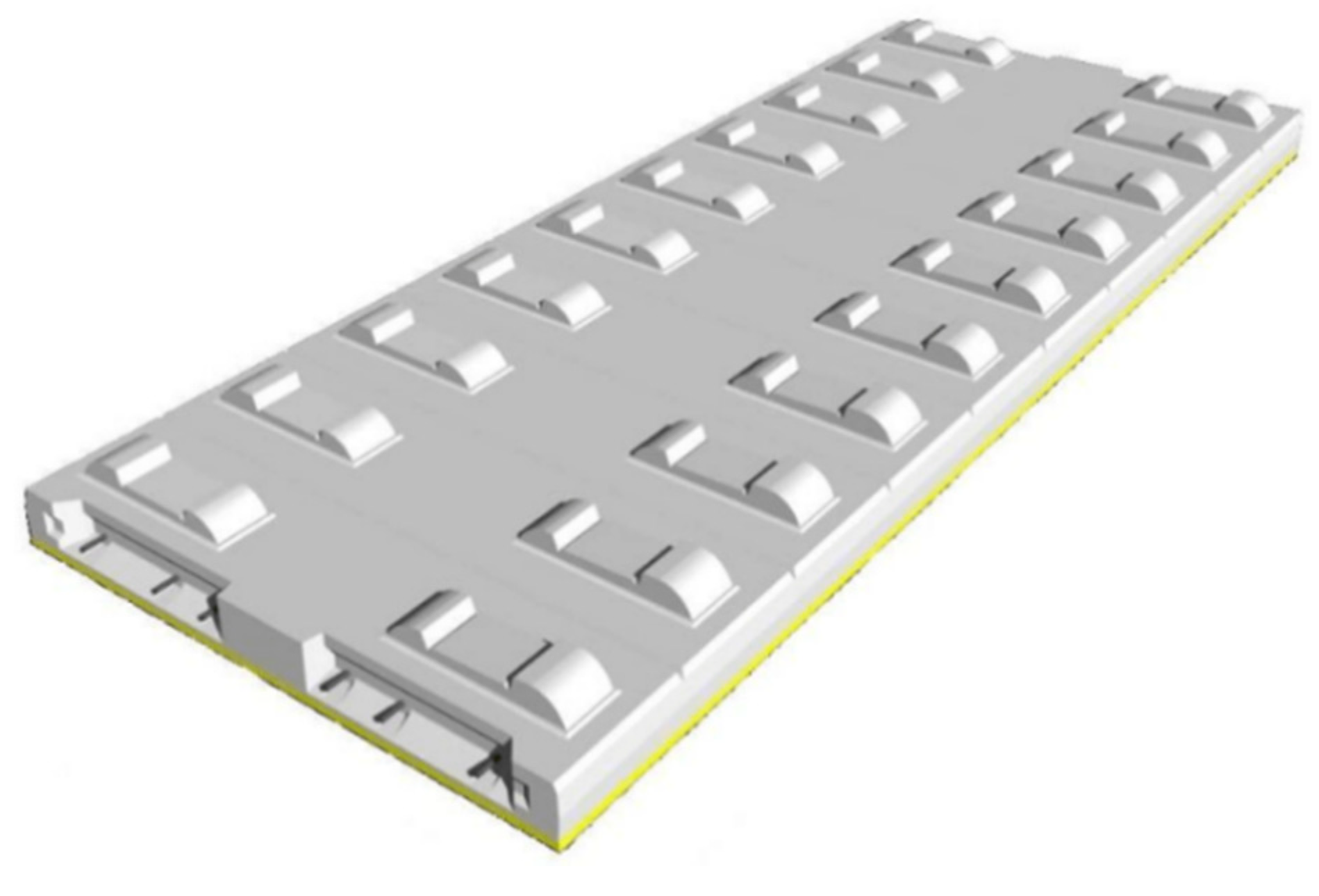
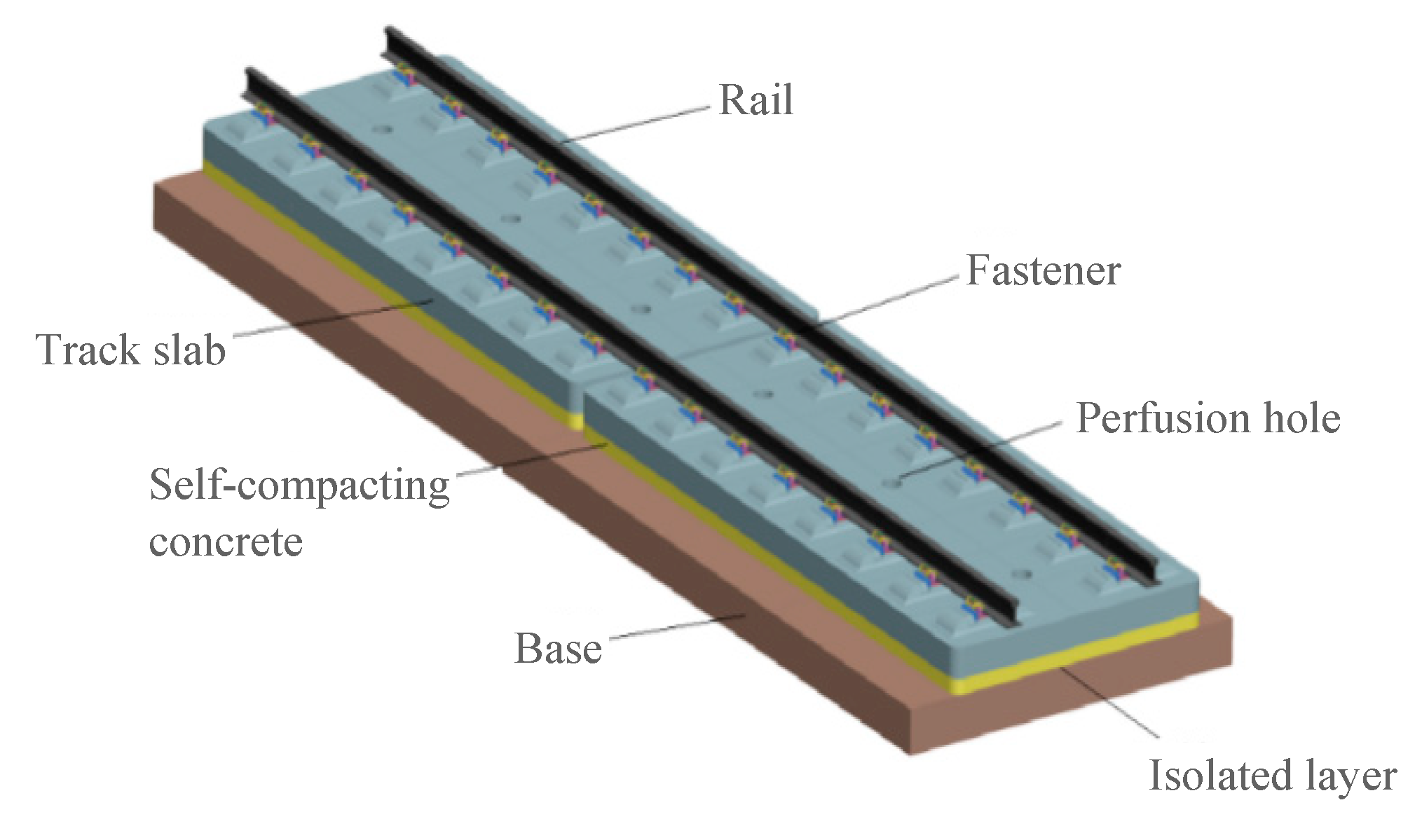
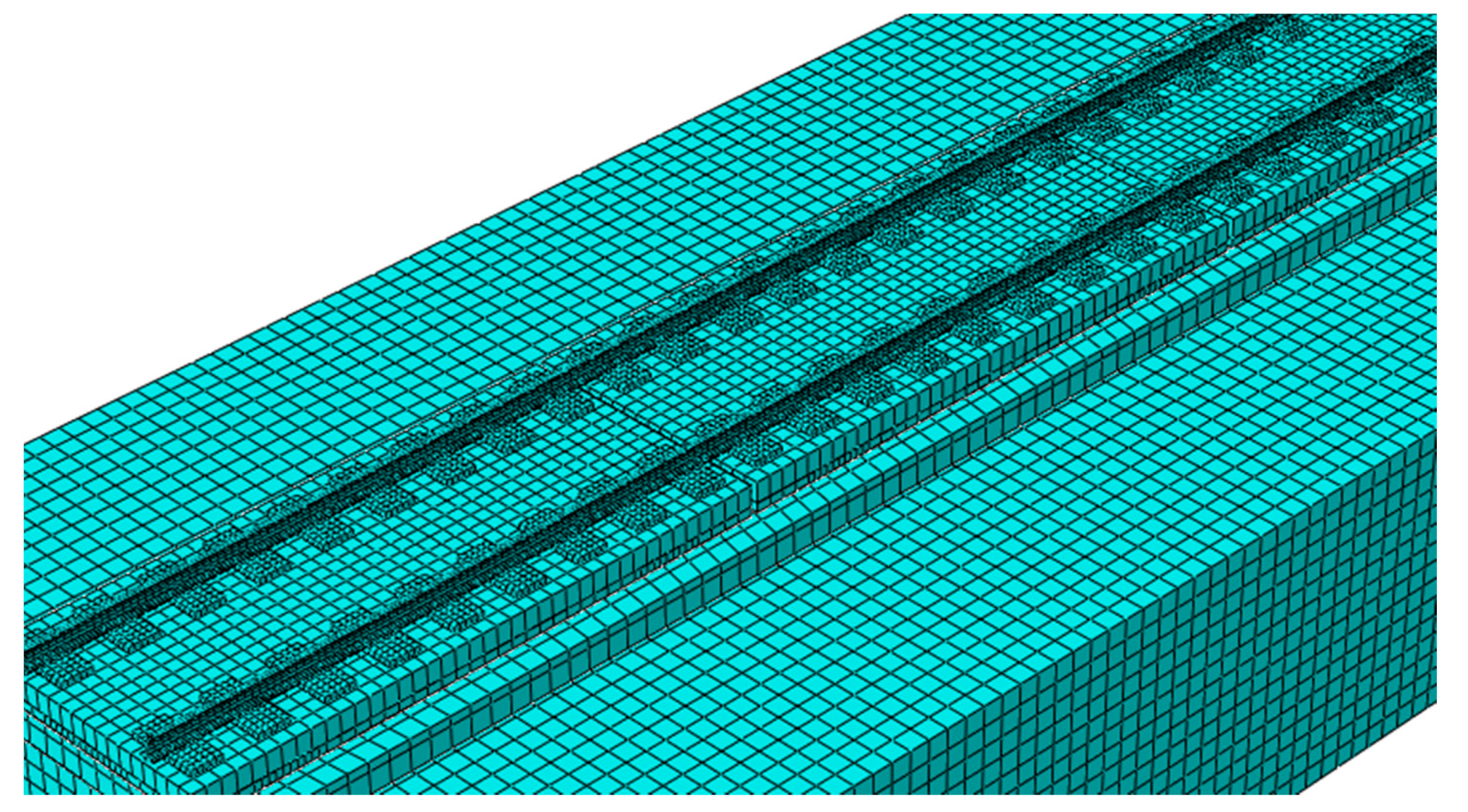
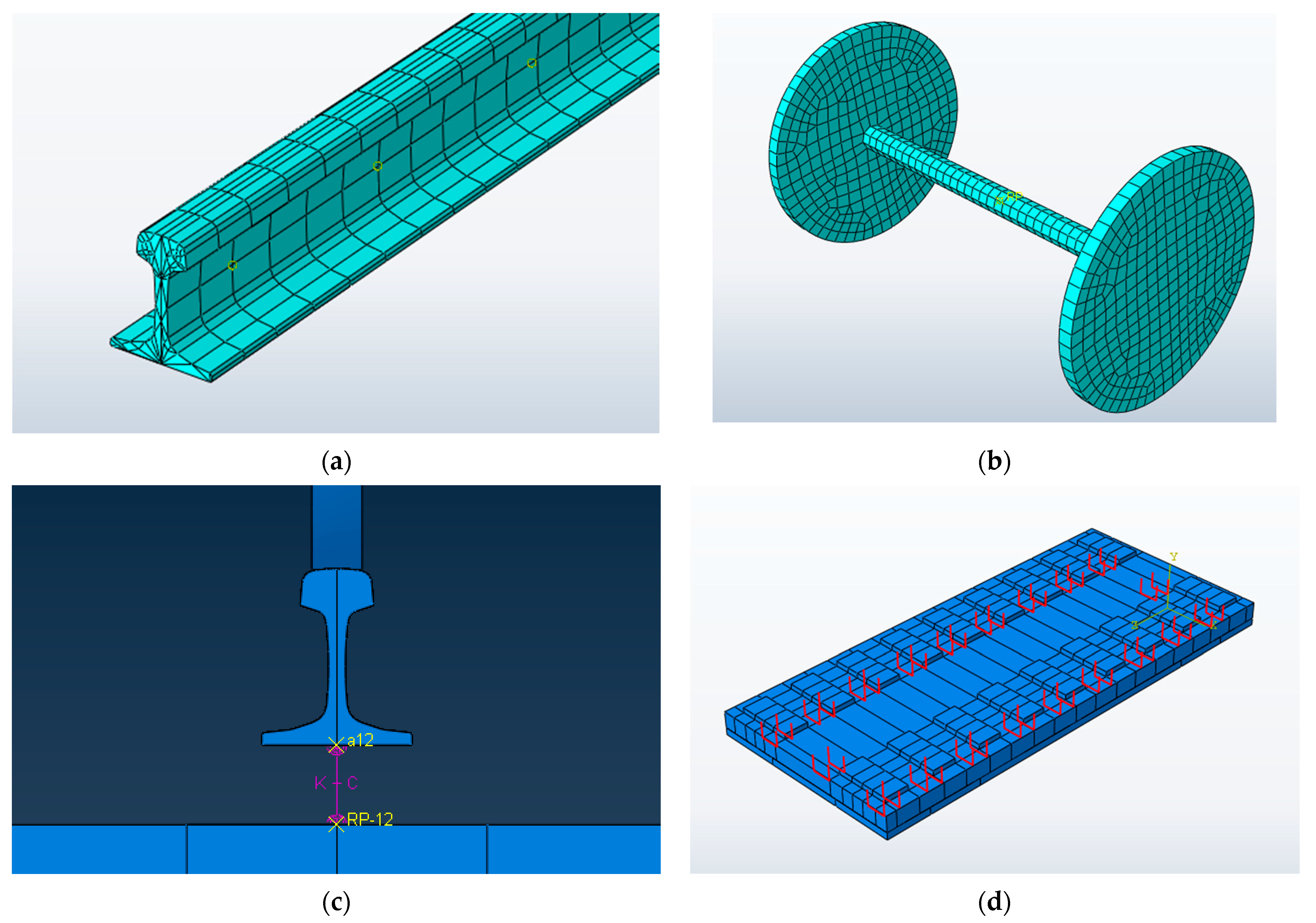
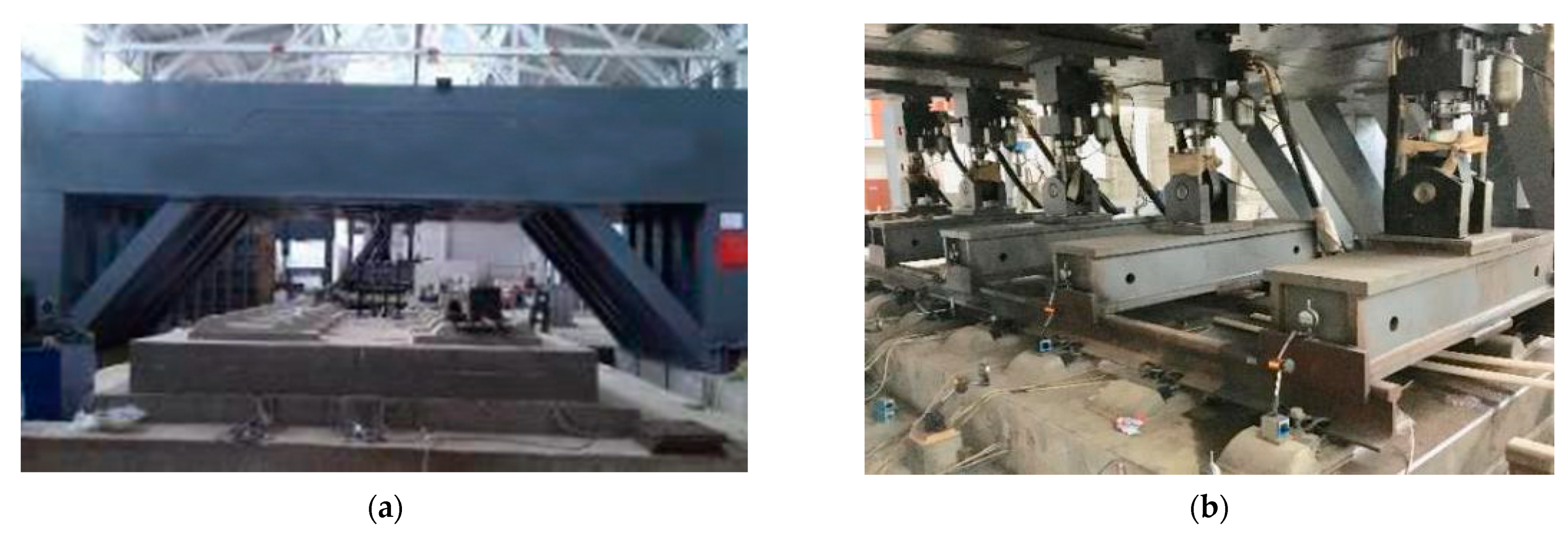

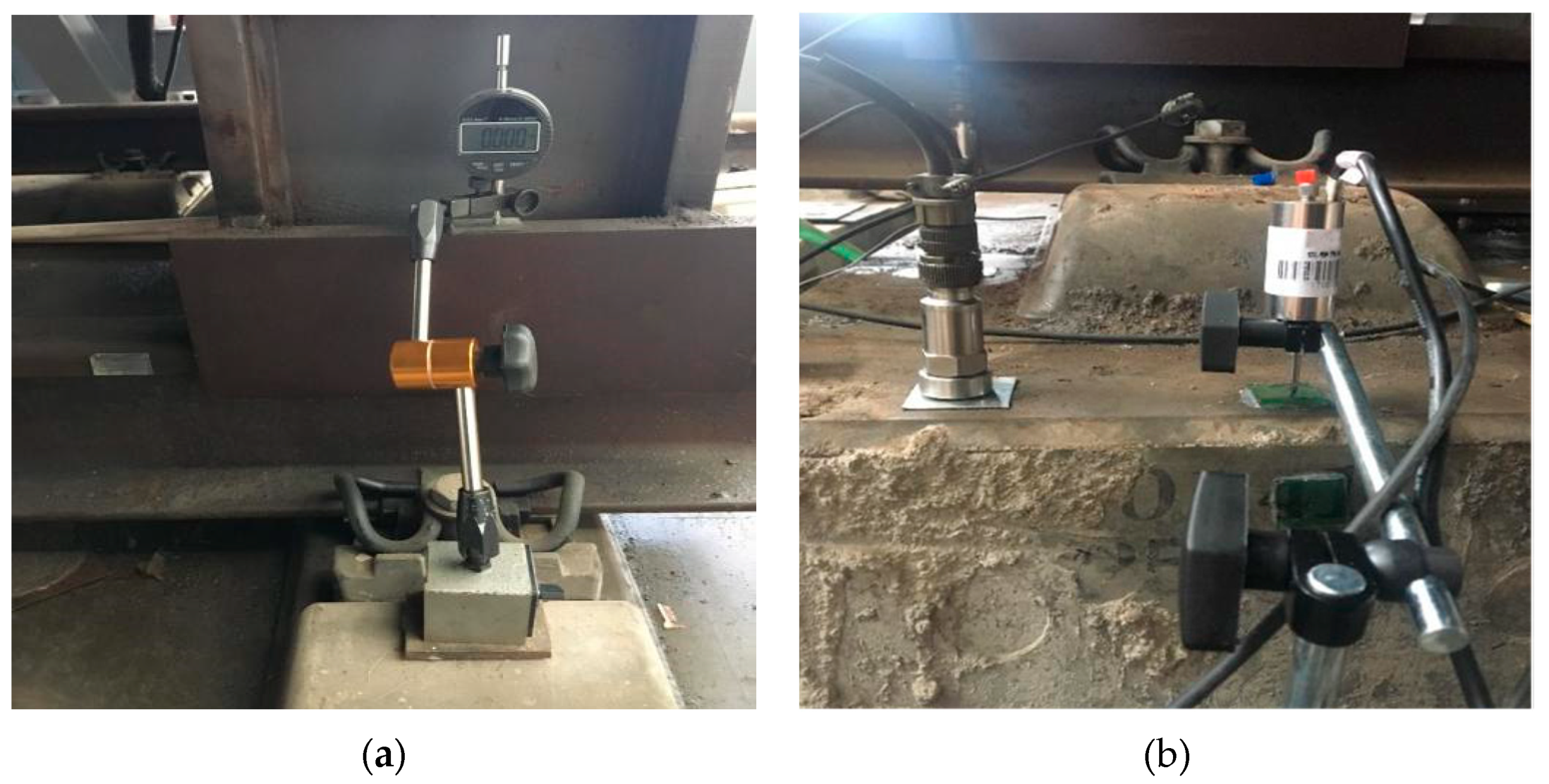
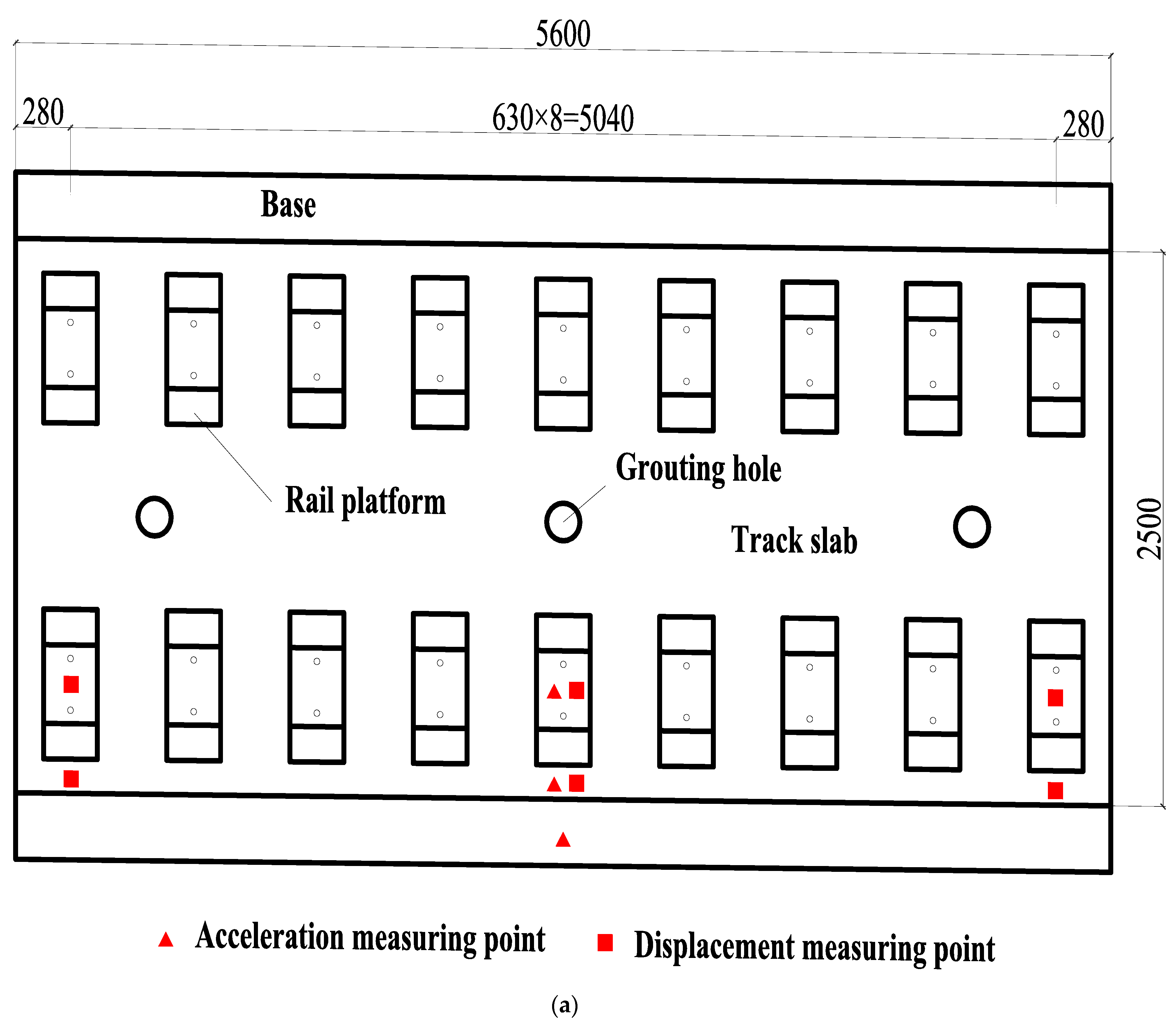


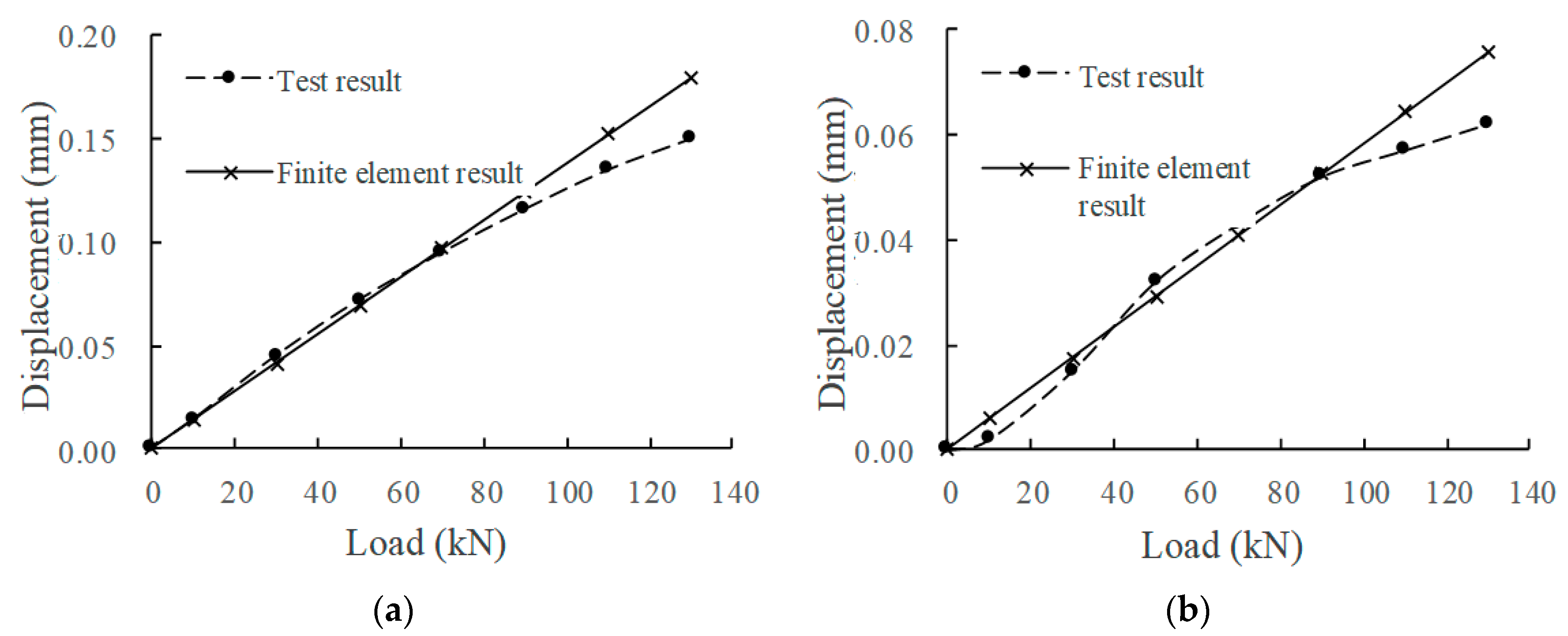




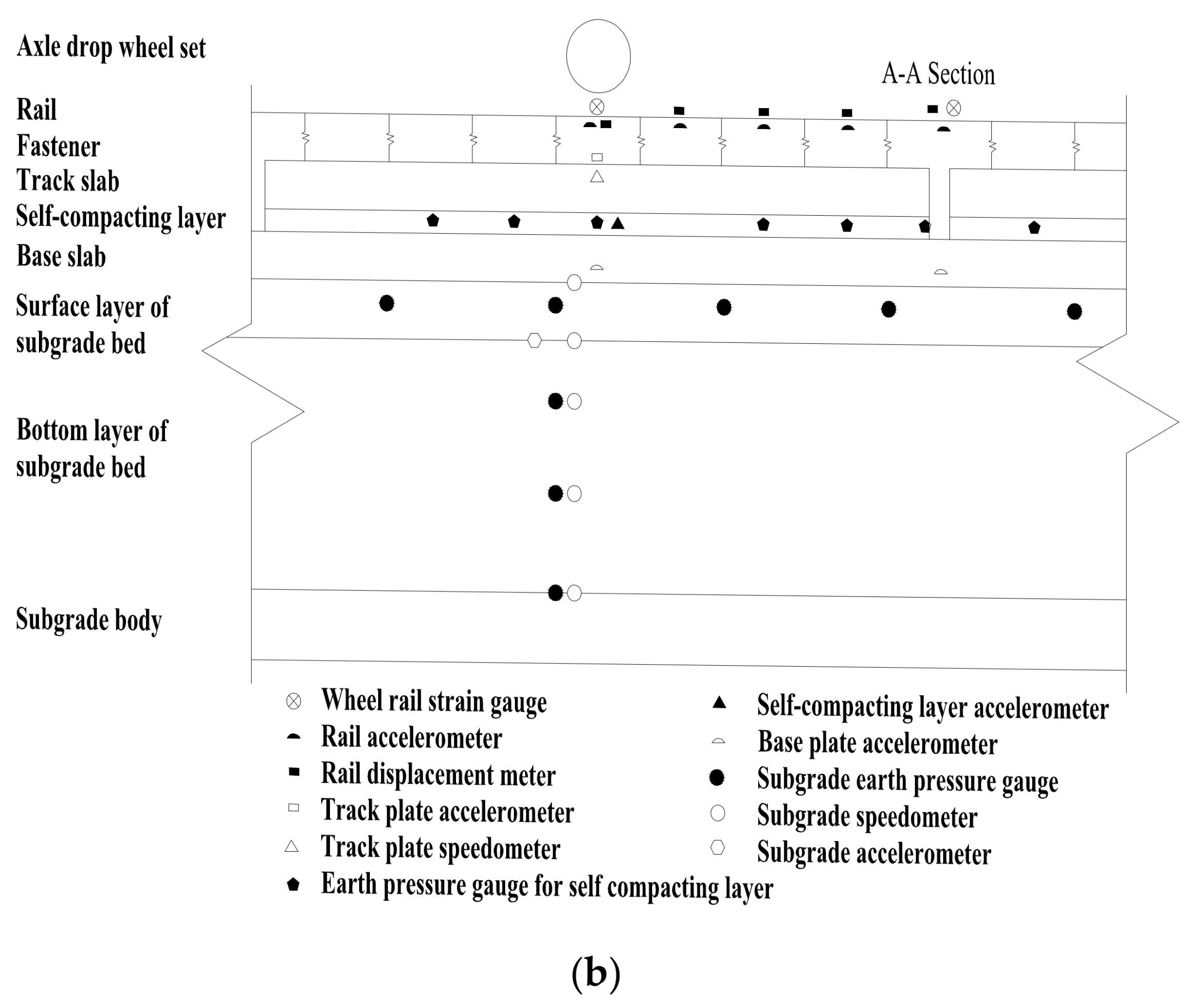
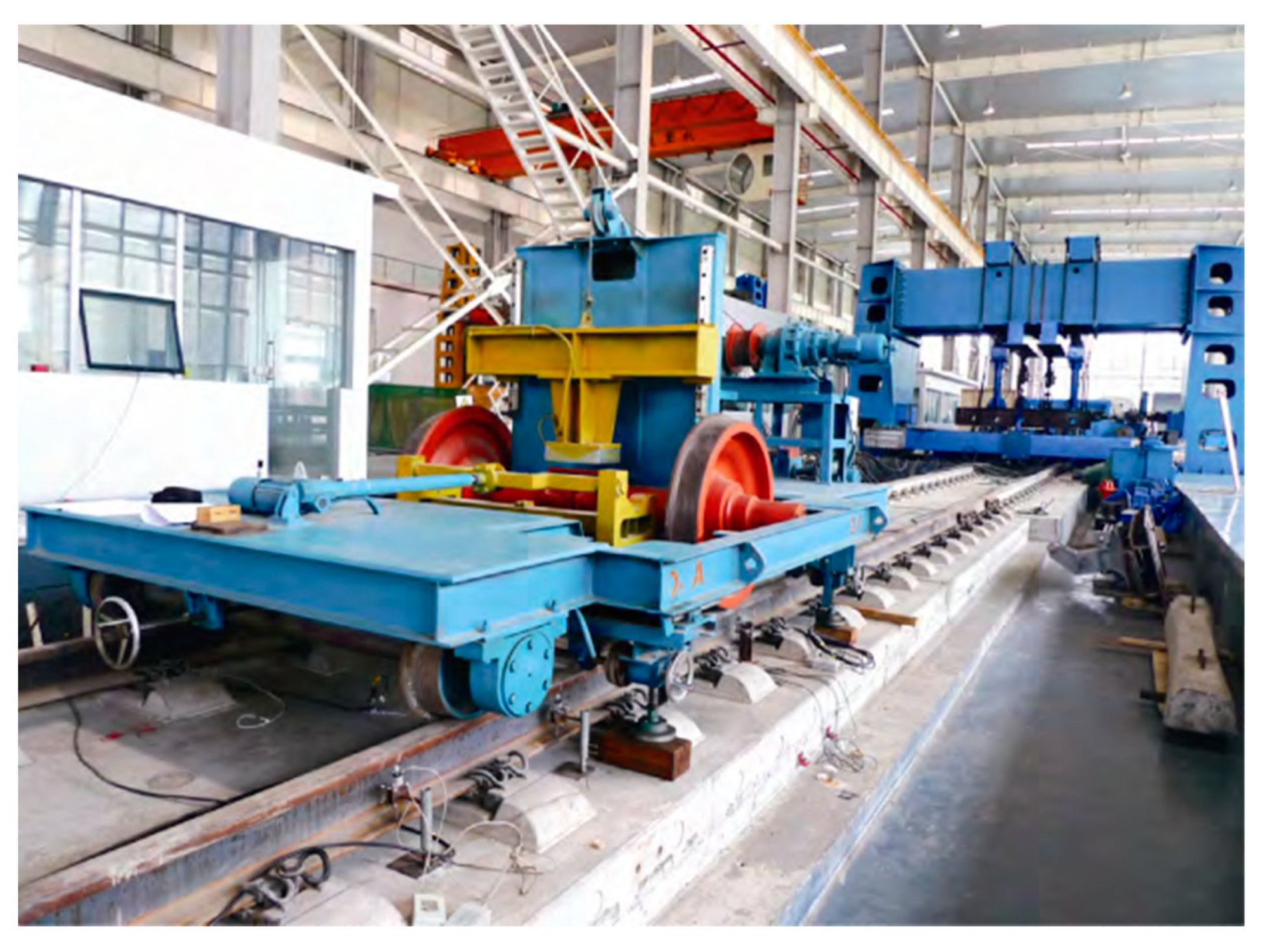
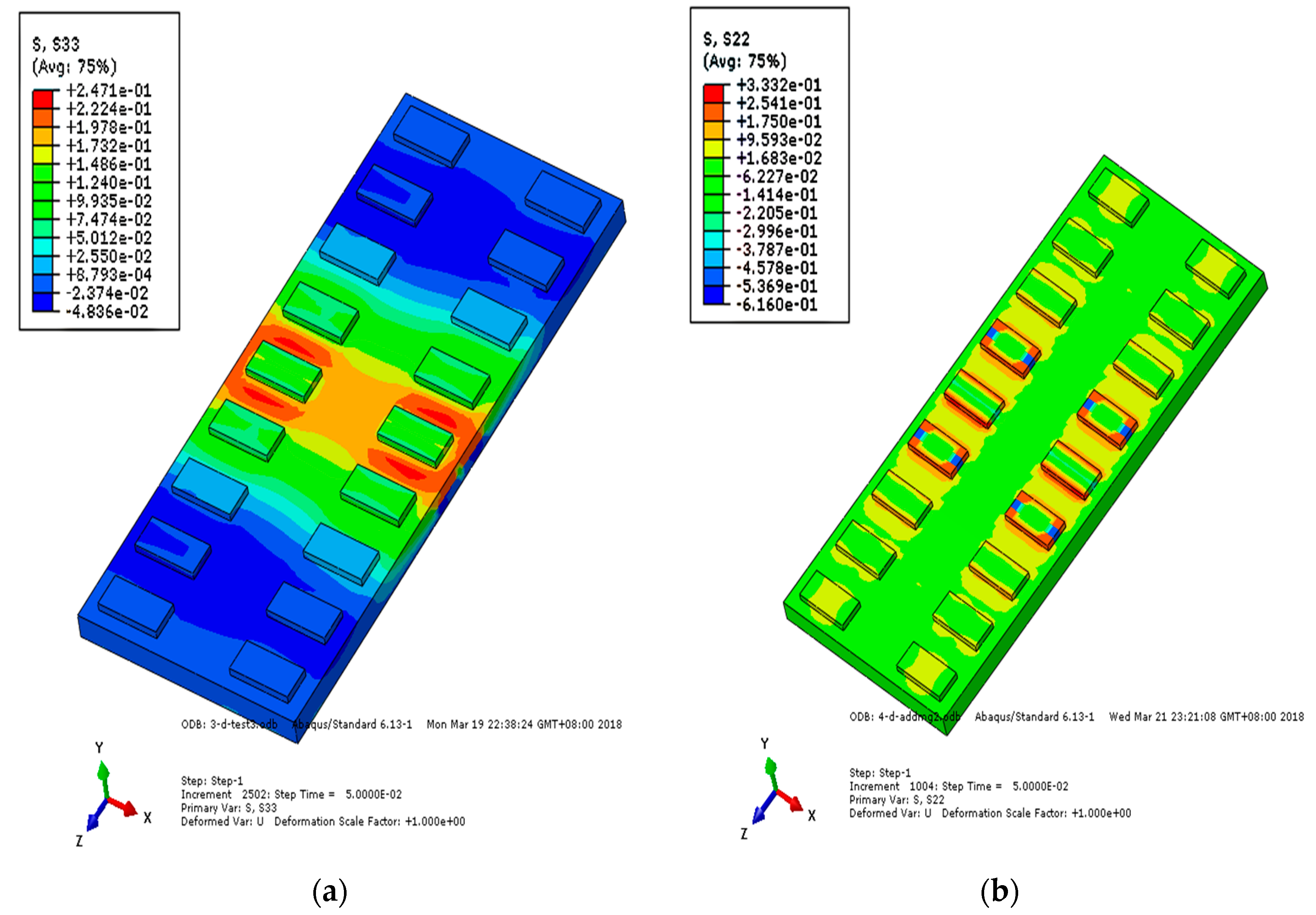
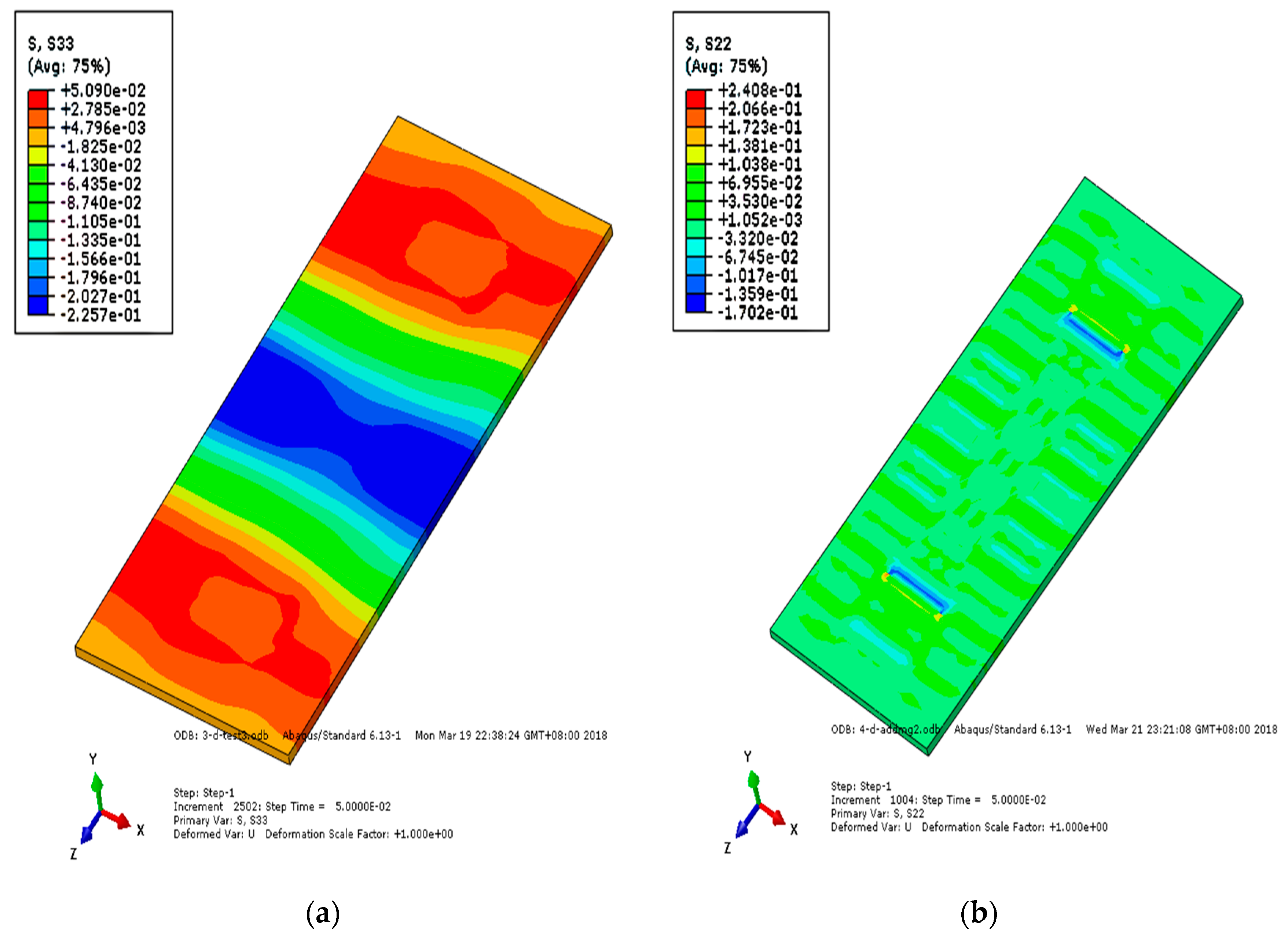
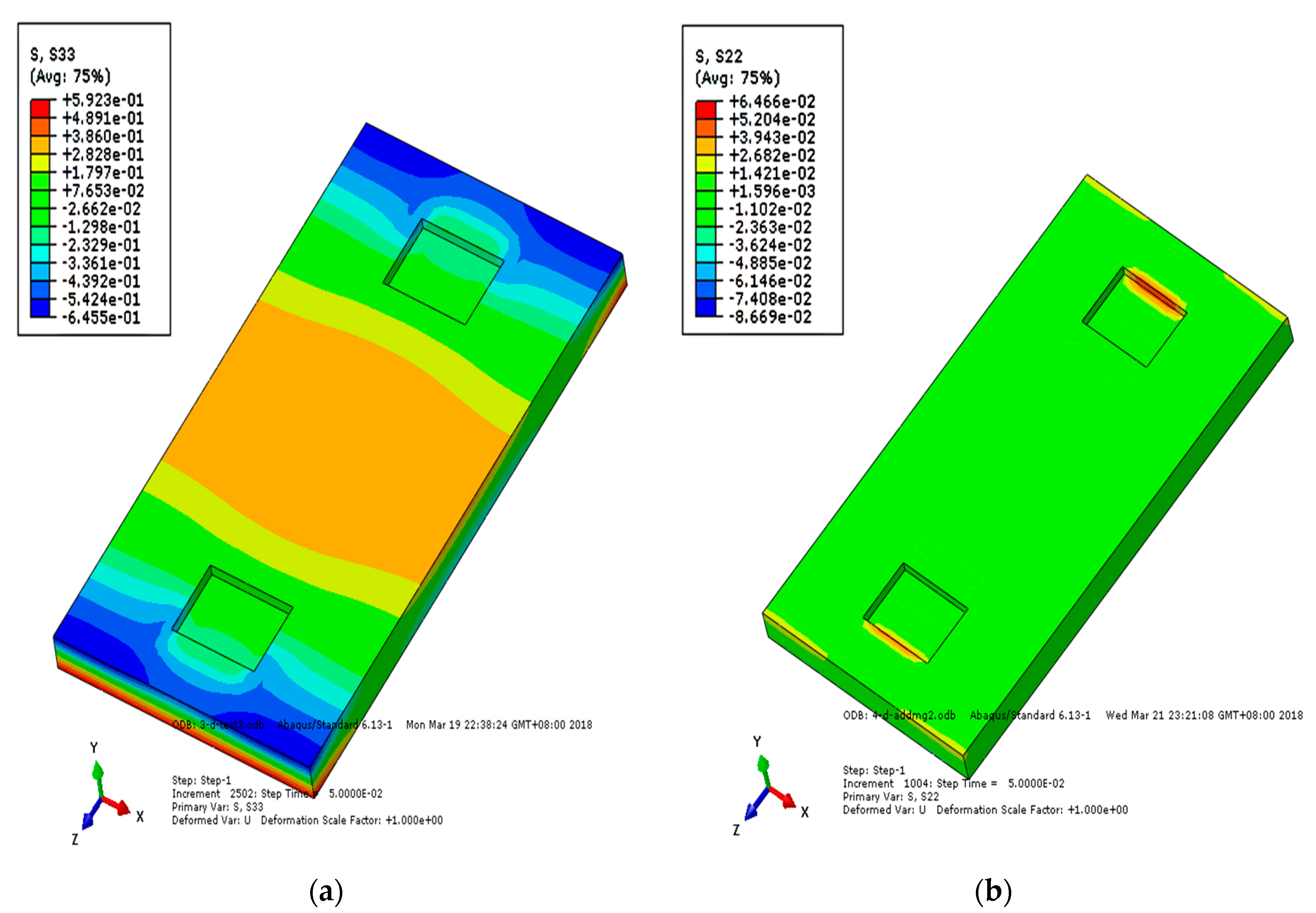

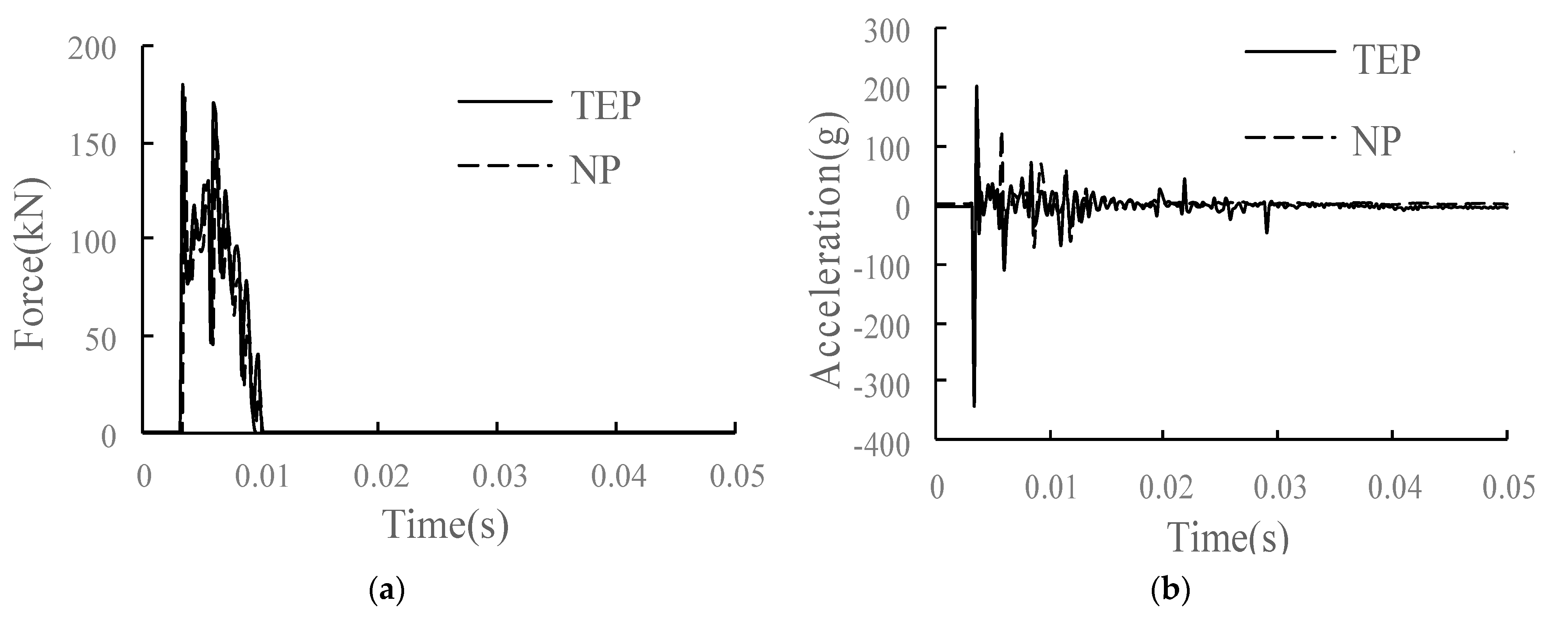
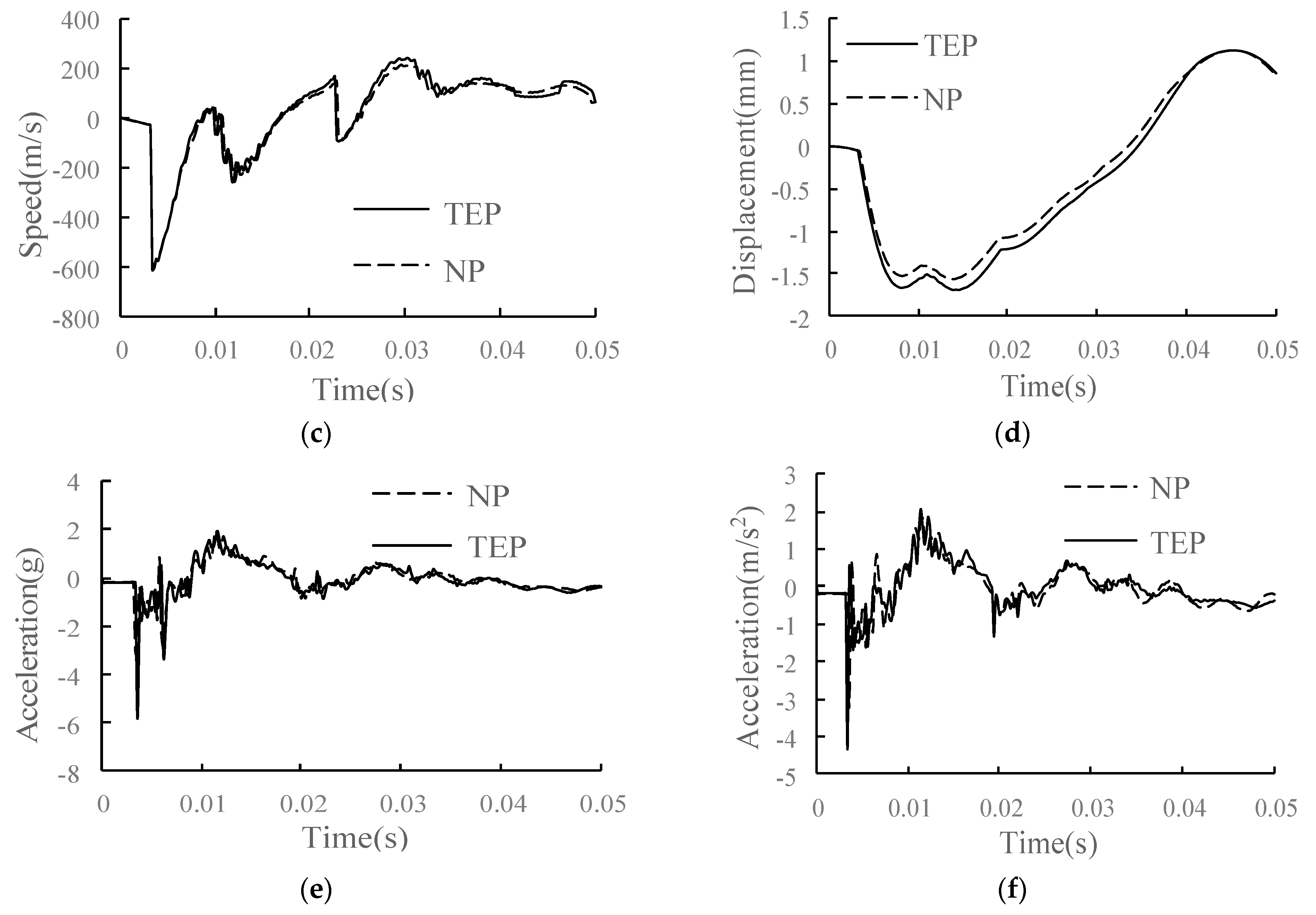
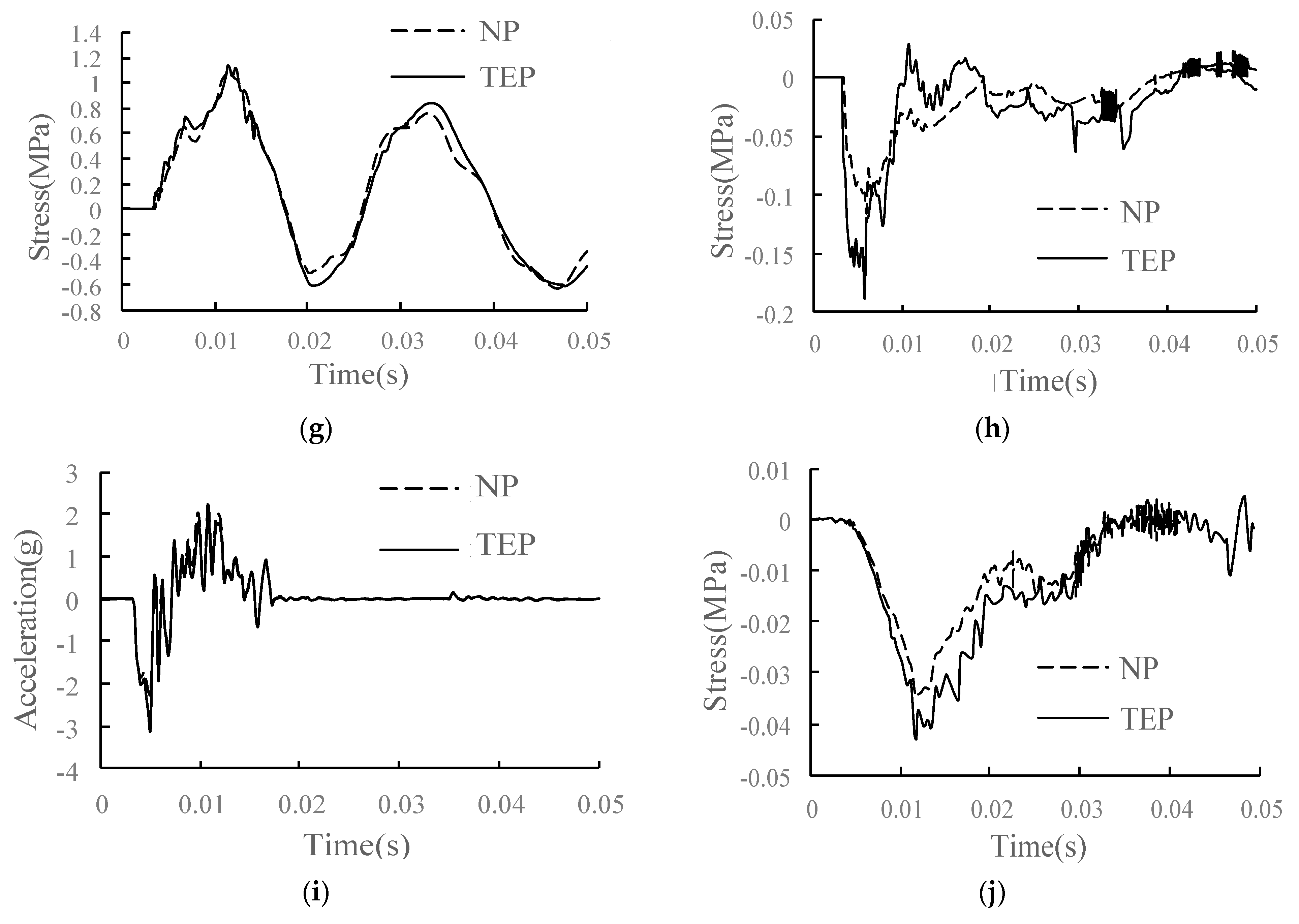
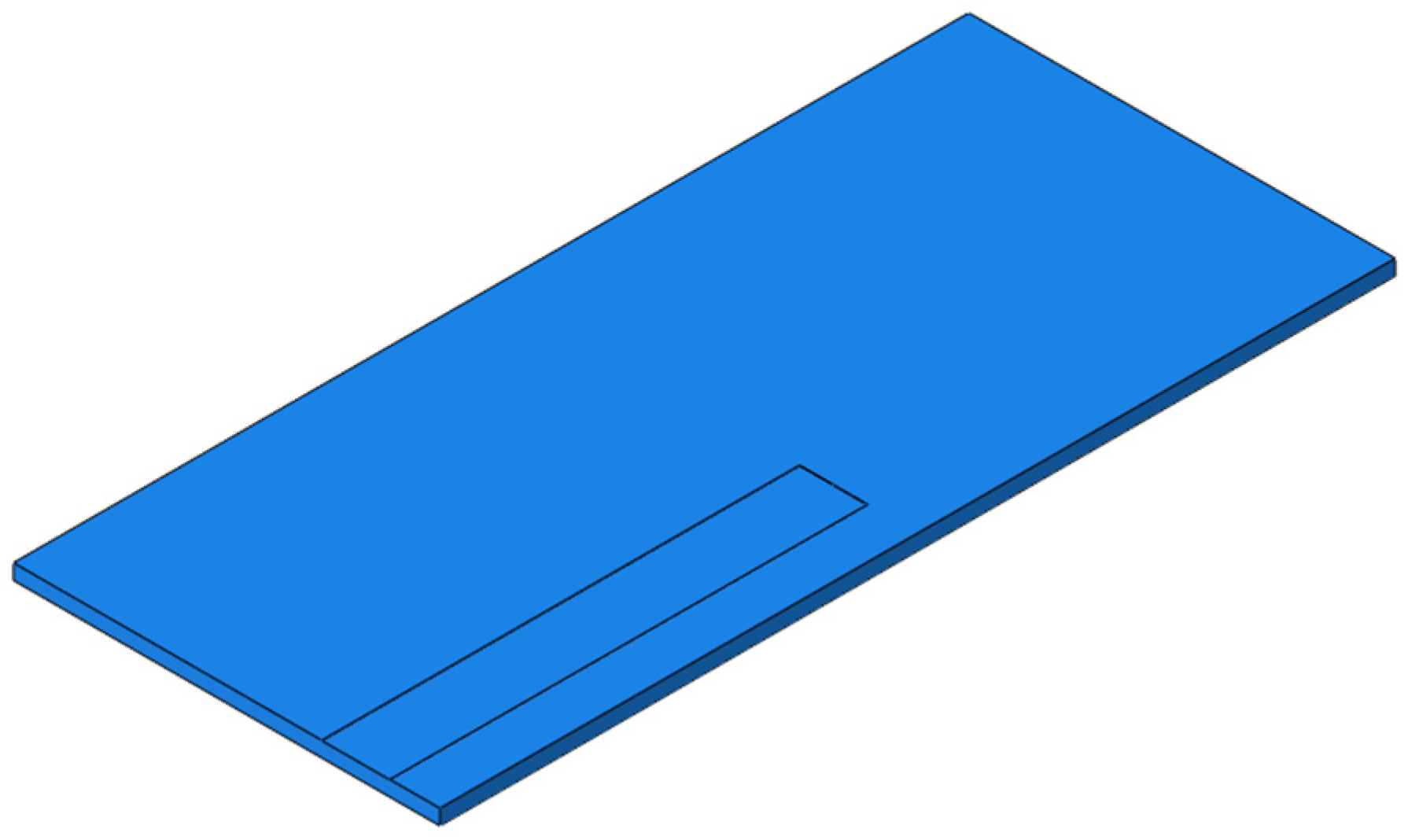

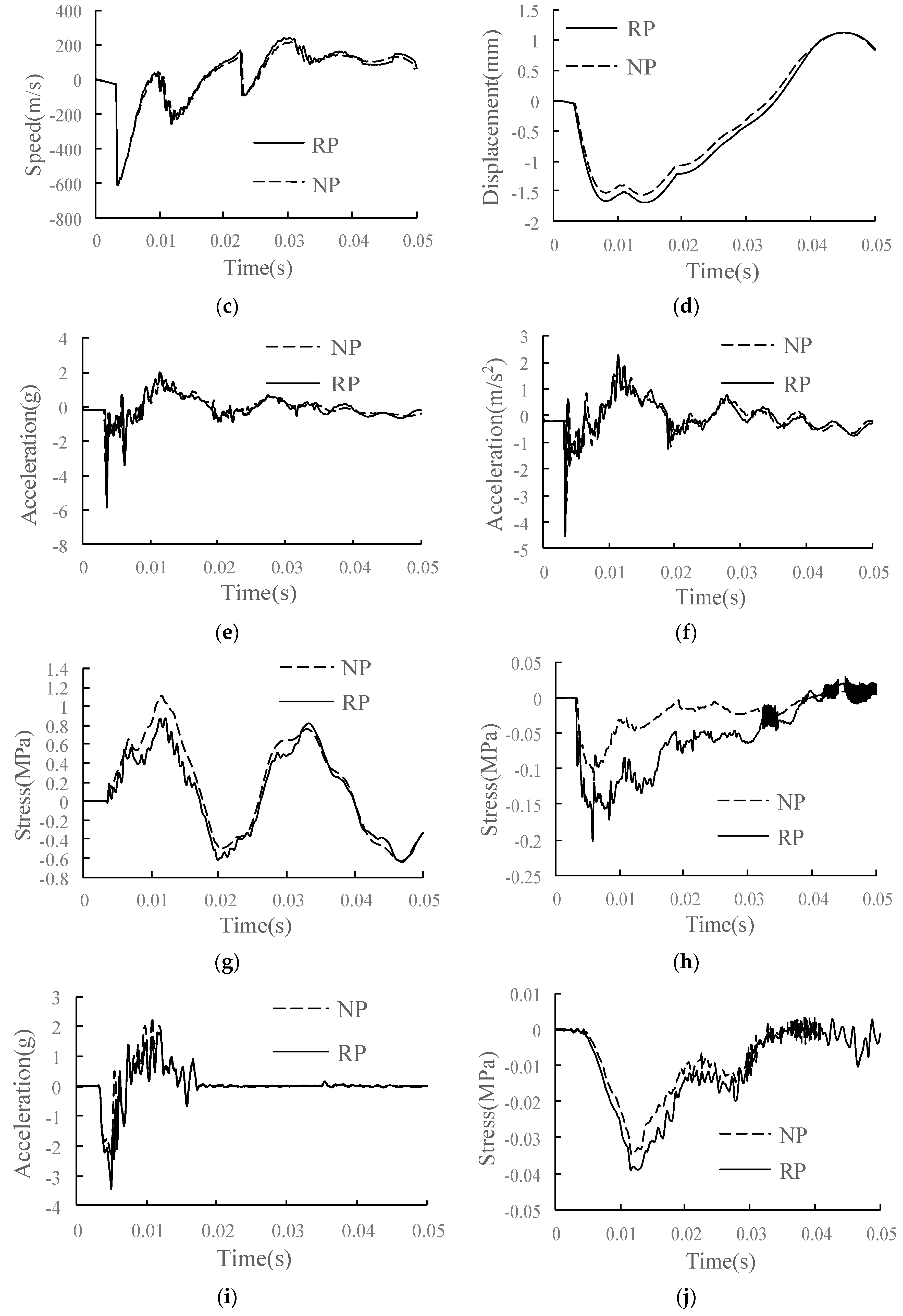
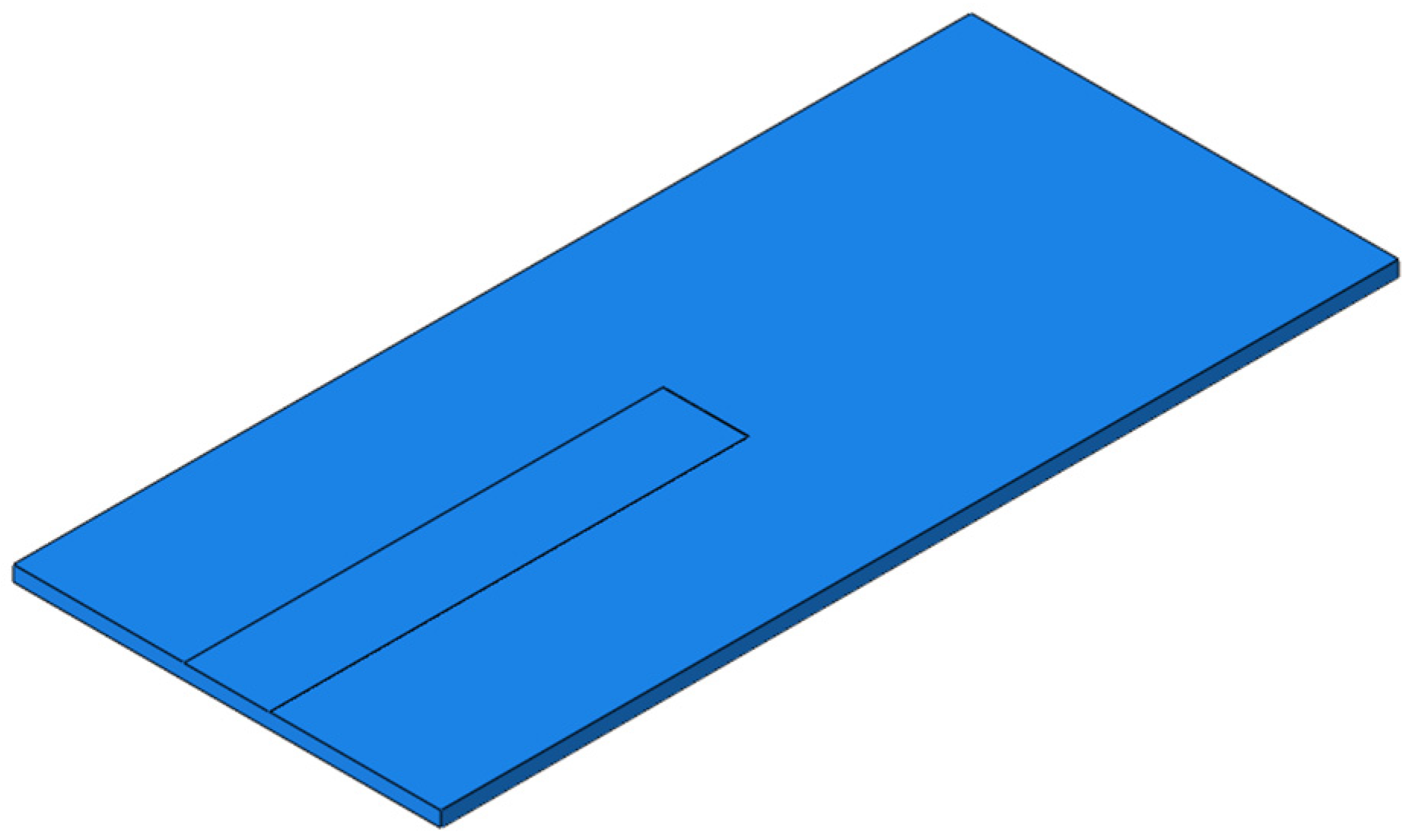
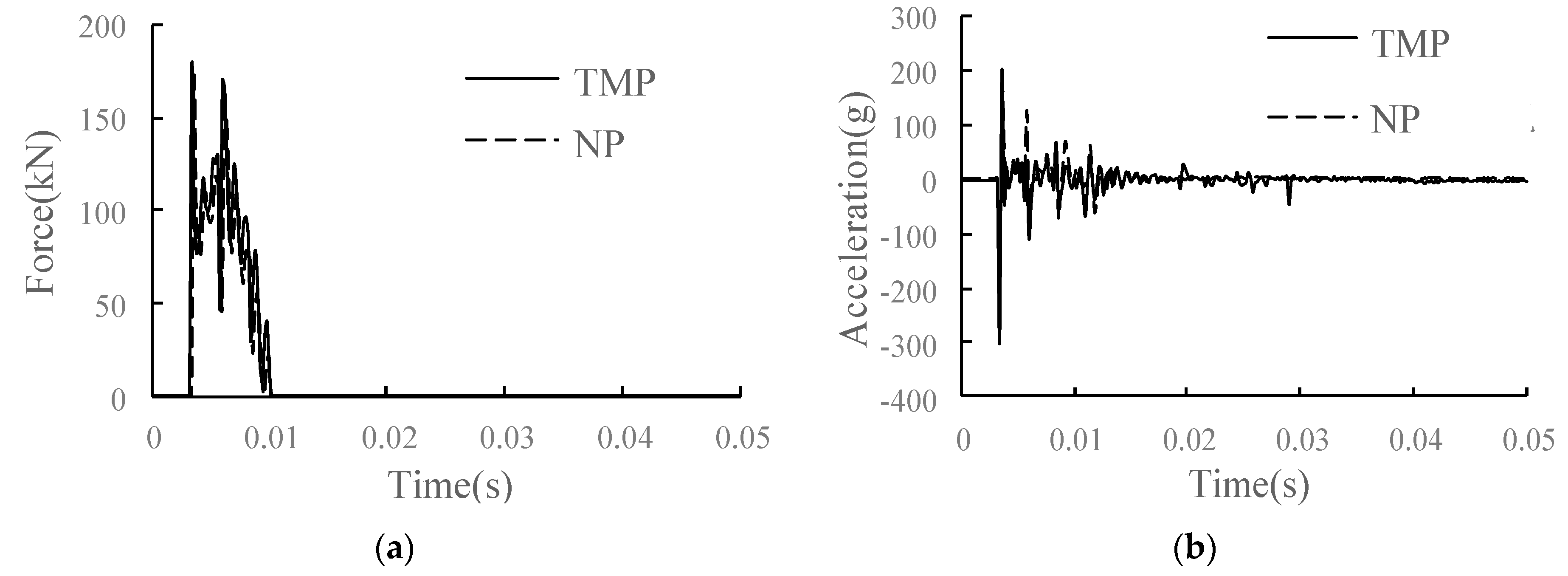

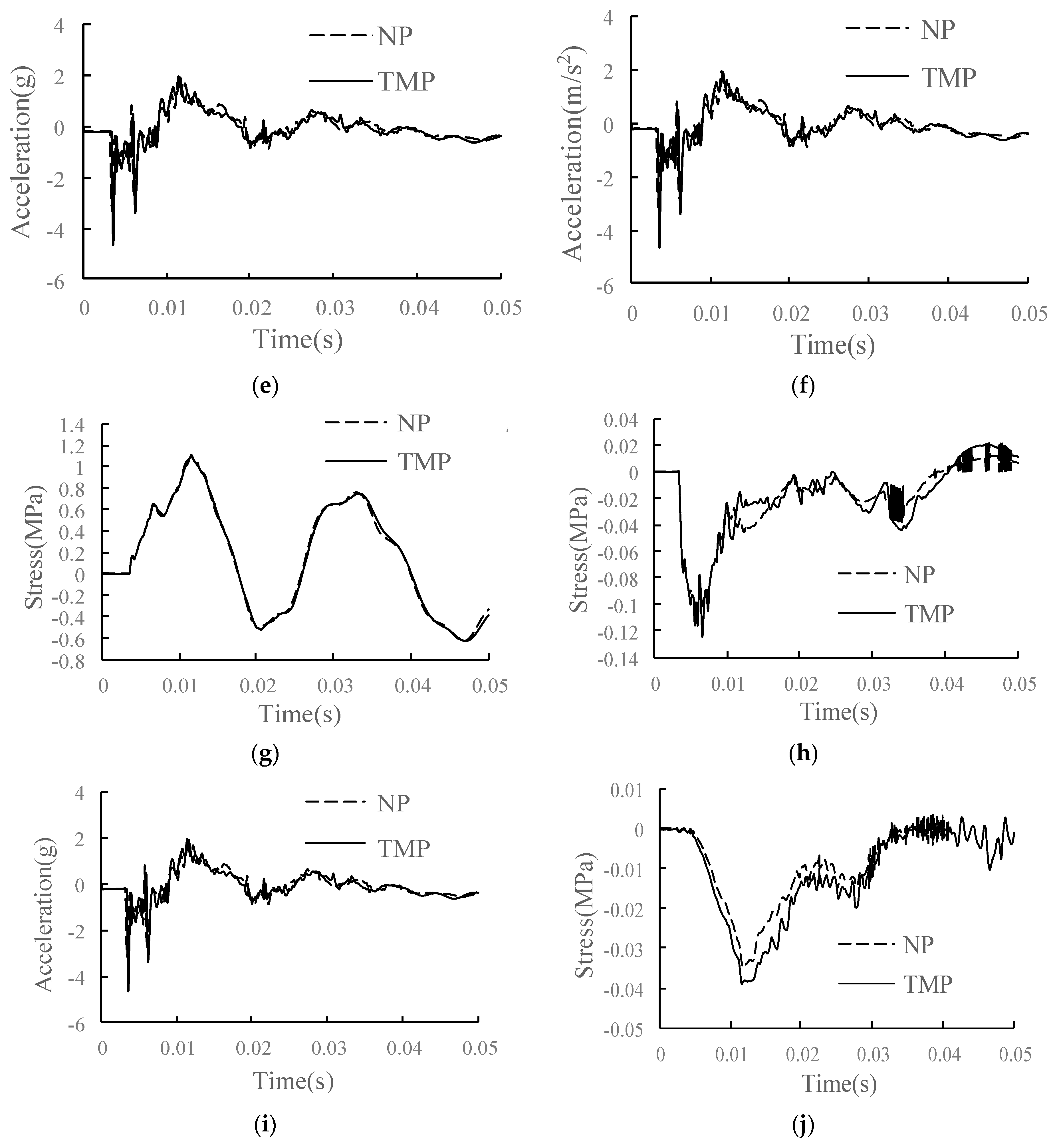
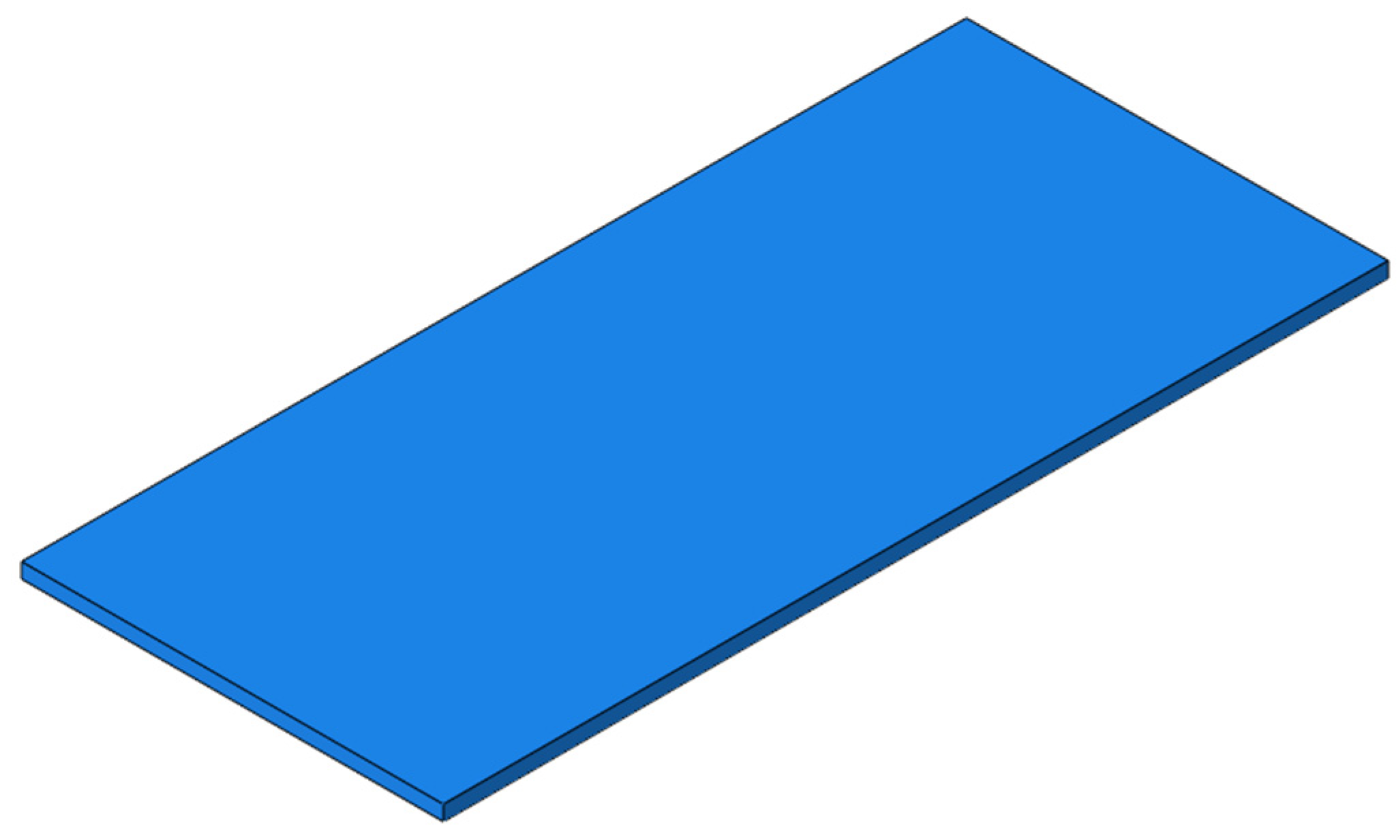
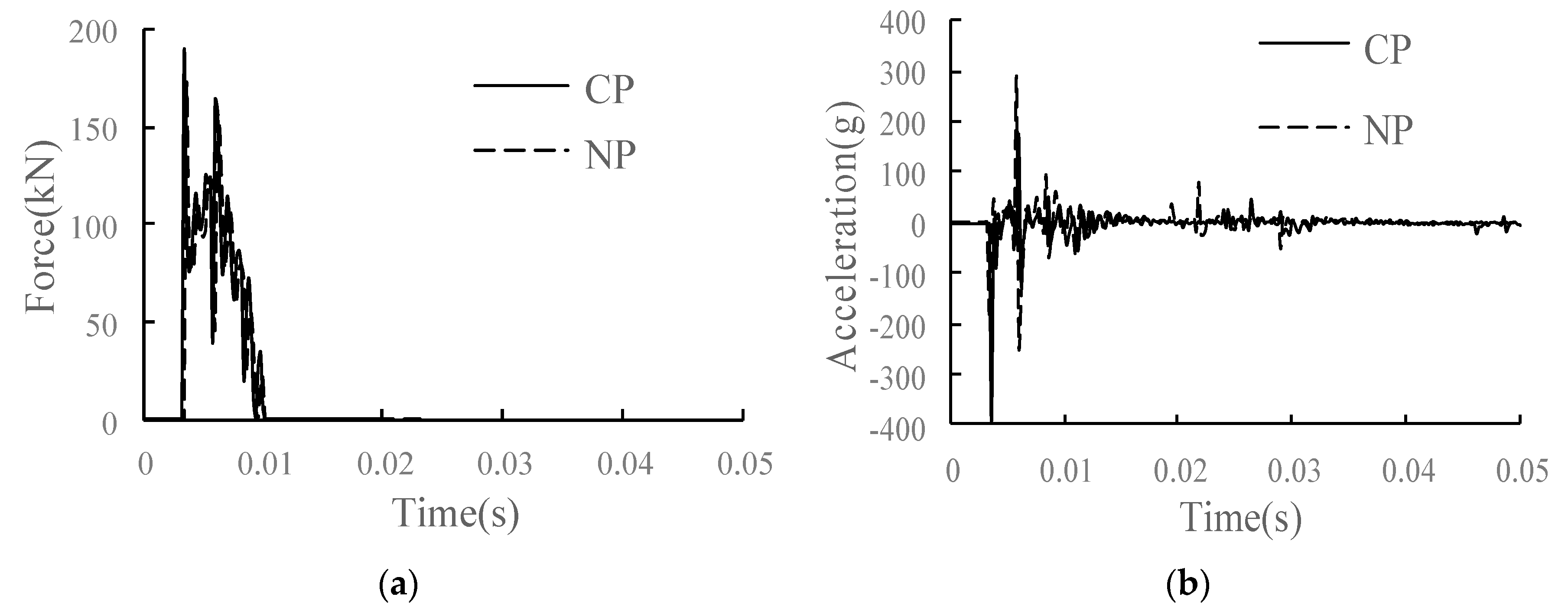


| Structural Components | Performance Parameter | Numerical Value |
|---|---|---|
| Rail | Elastic modulus (MPa) | 2.06 × 105 |
| Density (kg/m3) | 7.80 × 103 | |
| Poisson’s ratio | 0.3 | |
| Fastener | Stiffness (kN/mm) | 30 × 103 |
| Damping (kN·s/mm) | 0.05 | |
| Track slab | Elastic modulus (MPa) | 3.60 × 104 |
| Density (kg/m3) | 2.50 × 103 | |
| Poisson’s ratio | 0.17 | |
| SCC | Elastic modulus (MPa) | 3.4 × 104 |
| Density (kg/m3) | 2.40 × 103 | |
| Poisson’s ratio | 0.2 | |
| Base | Elastic modulus (MPa) | 3.2 × 104 |
| Density (kg/m3) | 2.50 × 103 | |
| Poisson’s ratio | 0.2 | |
| Surface layer of subgrade bed | Elastic modulus (MPa) | 300 |
| Density (kg/m3) | 1.95 × 103 | |
| Poisson’s ratio | 0.3 | |
| Bottom layer of subgrade bed | Elastic modulus (MPa) | 250 |
| Density (kg/m3) | 1.90 × 103 | |
| Poisson’s ratio | 0.25 |
| Index | Location | Paper Model | Literature [34] Test Value |
|---|---|---|---|
| Acceleration (g) | Rail | 261.3 | 239.2 |
| Track slab | 3.30 | 3.14 | |
| Base | 2.55 | 2.1 | |
| Speed (mm/s) | Rail | 610.2 | 601.8 |
| Track slab | 29.1 | 28.0 | |
| Base | 17.6 | — |
| Index | 10 Million Times | 20 Million Times | 30 Million Times |
|---|---|---|---|
| Fastener stiffness | 1.15 | 1.26 | 1.29 |
| Isolation layer stiffness | 1.78 | 2.18 | 2.44 |
| Index | Location | The Initial State | 10 Million Times | 20 Million Times | 30 Million Times |
|---|---|---|---|---|---|
| Wheel–rail force (kN) | Wheel–rail interface | 170.1 | 177.3 | 180.1 | 179.9 |
| Speed (mm/s) | Rail | 611.2 | 614.2 | 629.8 | 646.5 |
| Displacement (mm) | Rail | 1.52 | 1.48 | 1.44 | 1.39 |
| Acceleration (g) | Rail | 262.7 | 321.3 | 341.7 | 353.6 |
| Track slab | 3.11 | 3.10 | 3.14 | 3.16 | |
| Base | 2.57 | 2.79 | 2.94 | 3.03 | |
| Longitudinal stress (MPa) | Track slab | −1.01 | −1.02 | −1.03 | −1.04 |
| SCC | 1.17 | 1.06 | 1.01 | 1.01 | |
| Base | −1.37 | −1.46 | −1.48 | −1.49 | |
| Vertical stress (MPa) | Track slab | −0.46 | −0.50 | −0.51 | −0.52 |
| SCC | −0.11 | −0.12 | −0.13 | −0.14 | |
| Base | −0.0372 | −0.042 | −0.0485 | −0.0539 |
Publisher’s Note: MDPI stays neutral with regard to jurisdictional claims in published maps and institutional affiliations. |
© 2022 by the authors. Licensee MDPI, Basel, Switzerland. This article is an open access article distributed under the terms and conditions of the Creative Commons Attribution (CC BY) license (https://creativecommons.org/licenses/by/4.0/).
Share and Cite
Zeng, Z.; Xiao, Y.; Wang, W.; Huang, Z.; Wei, W.; Houdou, S.B. Research on Dynamic Performance of CRTSⅢ Type Slab Ballastless Track under Long-Term Service. Materials 2022, 15, 2033. https://doi.org/10.3390/ma15062033
Zeng Z, Xiao Y, Wang W, Huang Z, Wei W, Houdou SB. Research on Dynamic Performance of CRTSⅢ Type Slab Ballastless Track under Long-Term Service. Materials. 2022; 15(6):2033. https://doi.org/10.3390/ma15062033
Chicago/Turabian StyleZeng, Zhiping, Yancai Xiao, Weidong Wang, Zhibin Huang, Wei Wei, and Saidi Boumedienne Houdou. 2022. "Research on Dynamic Performance of CRTSⅢ Type Slab Ballastless Track under Long-Term Service" Materials 15, no. 6: 2033. https://doi.org/10.3390/ma15062033
APA StyleZeng, Z., Xiao, Y., Wang, W., Huang, Z., Wei, W., & Houdou, S. B. (2022). Research on Dynamic Performance of CRTSⅢ Type Slab Ballastless Track under Long-Term Service. Materials, 15(6), 2033. https://doi.org/10.3390/ma15062033






